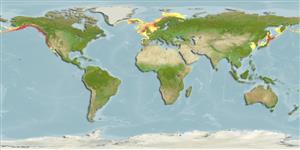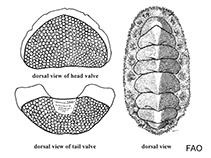Cryptochiton stelleri (Middendorff, 1847)
Giant Pacific chiton| Native range | All suitable habitat | Point map | Year 2050 |

|
| This map was computer-generated and has not yet been reviewed. |
| Cryptochiton stelleri AquaMaps Data sources: GBIF OBIS |
Upload your photos
Google image | No image available for this species;
drawing shows typical species in Acanthochitonidae.
Google image | No image available for this species;
drawing shows typical species in Acanthochitonidae.
Classification / Names Common names | Synonyms | CoL | ITIS | WoRMS
Polyplacophora | Chitonida | Acanthochitonidae
Environment: milieu / climate zone / depth range / distribution range Ecology
Benthic; depth range 0 - 60 m (Ref. 127878). Temperate
Distribution Countries | FAO areas | Ecosystems | Occurrences | Introductions
Pacific Ocean. Temperate to polar.
Length at first maturity / Size / Weight / Age
Maturity: Lm ? range ? - ? cm Max length : 32.5 cm TL male/unsexed; (Ref. 865)
Short description Morphology
Valves: Pure white; completely covered by what appears to be coarse maroon leather. Large white valves (Ref. 296).
Fisheries: The foot of the Gumboot Chiton is sometimes eaten in the same manner as the abalone (Ref. 296). Depth ranges from intertidal to 600 m. Inhabits a variety of bottom-types, but prefer stone and pebble (Ref. 290); at some periods in their life cycle, they teem into the intertidal zone (Ref. 339). Often found on the beach (Ref. 296).
Life cycle and mating behavior Maturity | Reproduction | Spawning | Eggs | Fecundity | Larvae
Members of the class Polyplacophora are mostly gonochoric. Life cycle: Eggs hatch into lecitotrophic planktonic trocophore larvae (no veliger stage) which later metamorphose and settle on the bottom as young adults.
Main reference
References | Coordinator | Collaborators
Burghardt, G. and L. Burghardt. 2006. (Ref. 296)
IUCN Red List Status (Ref. 130435)
CITES status (Ref. 108899)
Not Evaluated
CMS (Ref. 116361)
Not Evaluated
Threat to humans
Human uses
Fisheries: of potential interest
| FishSource |
Tools
More information
Internet sources
BHL | BOLD Systems | CISTI | DiscoverLife | FAO(Publication : search) | Fishipedia | GenBank (genome, nucleotide) | GloBI | Gomexsi | Google Books | Google Scholar | Google | PubMed | Tree of Life | Wikipedia (Go, Search) | Zoological Record
Estimates based on models
Preferred temperature
(Ref. 115969): 1.5 - 9.9, mean 6 (based on 341 cells).
Price category
(Ref. 80766):
Unknown.



